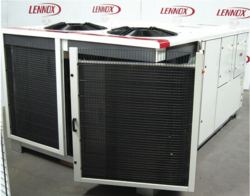Lennox advances the art of rooftop air conditioners

Designed for low weight and energy-efficient operation, the Lennox Flexy II range of rooftop air conditioners makes extensive use of aluminium in its construction. Note the hinged access coil, a patented feature to reduce unit size and improve access.
With the development of a new range of rooftop air conditioning units, Lennox has attempted to redefine standards for energy efficiency.Roof-top air conditioners are extensively used throughout Europe as an integrated solution for cooling and heating certain types of building. At their simplest, they incorporate a fan to draw air from the space, filter it, introduce fresh air, provide heating or cooling and then deliver the treated air to the space. They are particularly suited to single-storey buildings with ducted air distribution where precise control of the internal environment is not vital. Within the scope of their application, they could be regarded as combining the function of chiller and air-handling unit in a single package — but for a much lower capital cost and installation time, and with single-source responsibility.
Market share The European market is around 11 500 units a year with a value of about £85 million, according to Herve Dumont, marketing director with Lennox Europe and based at Dijon in France. There are seven major players, with Lennox claiming a market-leading share of over 30% by value. That market position is based on the Flexy range, a design introduced 10 years ago and now being superseded by the Flexy II range made in the factory at Dijon. The new range offers cooling capacities up to 230 kW, compared with an upper limit of about 170 kW previously. Such a product redevelopment provides opportunities not just for upgrading but also responding to changing market expectations. Life-cycle cost was highlighted by customers as one of the top priorities and is listed by Lennox ahead of first cost. Low weight was another customer concern, largely because it is common practice in much of Europe to drop units into position by helicopter. The extensive use of aluminium results in a huge reduction in weight with a unit offering 170 kW of cooling weighing 1430 kg, compared with 1950 kg for the nearest competitor and up to 2295 kg for other manufacturers’ products. The weight of the Flexy II unit is within the capability of the commonly used Eurocopter Ecureuil 350 B3. In line with environmental concerns, Flexy II units use R410A with specially developed Copeland scroll compressors. Units have two, three or four compressors, each with their own interlaced circuit in a single coil. Herve Dumont explains that this configuration significantly enhances part-load efficiency. For example, a unit with two compressors running at full load might achieve a COP of 2.7. At part load, with one compressor running, a COP of 3.8 might be achieved. If each compressor had its own coil, the COP with one compressor running would be the same as at full load — namely 2.7. Rooftop air conditioners spend much more time at part load than at full load, so improving refrigeration part-load efficiency is important to increasing overall efficiency and reducing energy use of the units. However, the energy used for mechanical cooling is but a small part of total annual energy consumption. As Herve Dumont explains, for much of the year, free cooling by introducing controlled amounts of fresh air will enable the desired environmental conditions to be provided — without having to use mechanical cooling. Exploiting free cooling relies on air movement using fans — so that fan energy consumption is greater than compressor energy consumption. To reduce fan energy consumption, Lennox has reduced resistance to airflow within the new units and also benefited from improvements in fan and motor technology.
Plug fans While standard Flexy II units use belt-driven centrifugal fans, Lennox also offers units with high-efficiency plug fans with variable-speed control to enable air volume to be matched to requirements. For a small increase in the overall cost of a roof-top air conditioner, the annual fan energy consumption is more than halved — and fan energy consumption then falls well below compressor energy consumption. The energy required to heat or cool incoming fresh air has also been considered with a damper system to accurately control the amount drawn in to the building. Temperature sensors for supply, return and outdoor air provide the data for calculating the amount of fresh air being introduced so that the damper position can be adjusted as required. The reductions in running costs are demonstrated by Lennox in comparisons of the original Flexy range with the Flexy II range. The comparison is based on units with 150 kW of cooling capacity and airflows of 28 000 m3/h. Improved compressor technology and the interlaced coil configuration, coupled with accurate control of fresh air, reduce compressor running costs by nearly 29%. Incremental improved in belt-driven fan technology and lower air resistance reduce fan energy costs by nearly 10%. However, exploiting the benefits of plug fans with variable-speed drives eclipses those savings — with a further 50% reduction in fan energy costs, or 55% less than the original Flexy range.
Impressive The overall reduction in energy costs over the original Flexy is 19% for the standard Flexy II and over 42% for the high-efficiency version. The energy-cost saving of the high-efficiency Flexy II over the standard version is an impressive 30%. All those highly attractive savings are rather diluted by the cost of gas for space heating — over 60% of the annual running cost of the Flexy II. The standard atmospheric burner is 92% efficient. A modulating burner is available, and a further energy-saving option is a plate heat exchanger of 48%. Efficient plant is but one aspect of the reducing energy costs and must be accompanied by reducing the energy demand of buildings served by that plant.
Lennox in the UK is at Cornwell Business Park, Salthouse Road, Brackmills, Northampton NN4 7EX
Related links:
Related articles:








